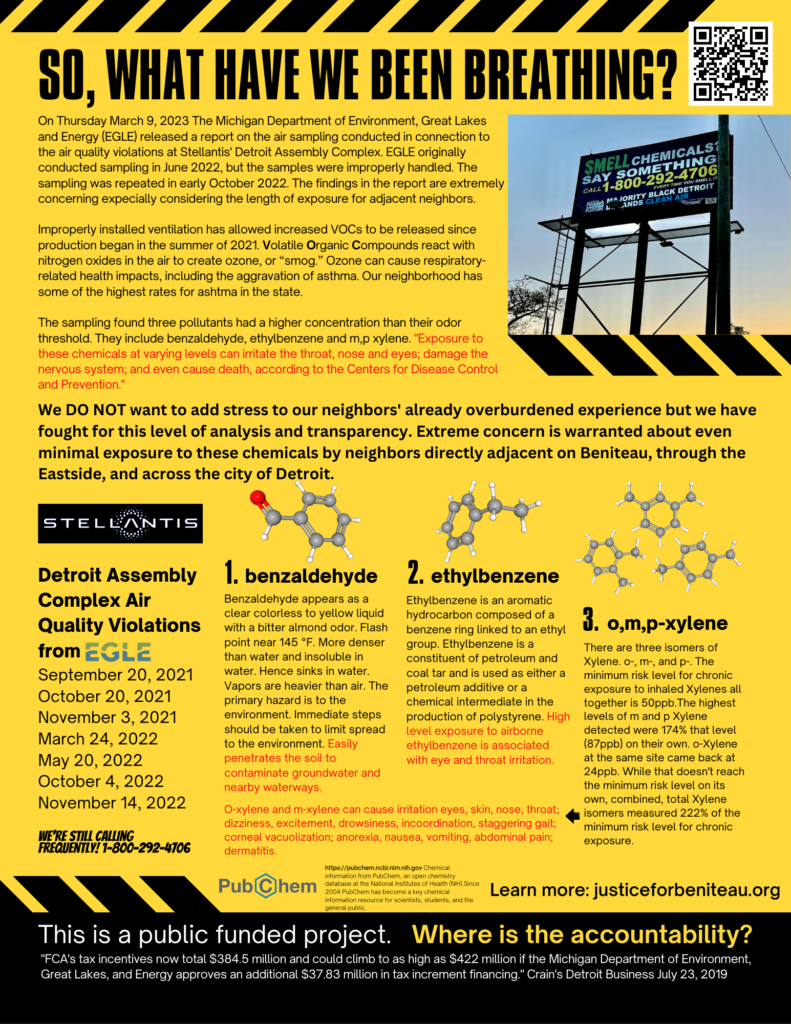
On Thursday March 9, 2023 The Michigan Department of Environment, Great Lakes and Energy (EGLE) released a report on the air sampling conducted in connection to the air quality violations at Stellantis’ Detroit Assembly Complex. EGLE originally conducted sampling in June 2022, but the samples were improperly handled. The sampling was repeated in early October 2022. The findings in the report are extremely concerning especially considering the length of exposure for adjacent neighbors.
Improperly installed ventilation has allowed increased VOCs to be released since production began in the summer of 2021. Volatile Organic Compounds react with nitrogen oxides in the air to create ozone, or “smog.” Ozone can cause respiratory-related health impacts, including the aggravation of asthma. Our neighborhood has some of the highest rates for ashtma in the state.
The sampling found three pollutants had a higher concentration than their odor threshold. They include benzaldehyde, ethylbenzene and m,p xylene. “Exposure to these chemicals at varying levels can irritate the throat, nose and eyes; damage the nervous system; and even cause death, according to the Centers for Disease Control and Prevention.”
Detroit Assembly Complex Air Quality Violations From EGLE
September 20, 2021
October 20, 2021
November 3, 2021
March 24, 2022
May 20, 2022
October 4, 2022
November 14, 2022
We DO NOT want to add stress to our neighbors’ already overburdened experience but we have fought for this level of analysis and transparency. Extreme concern is warranted about even minimal exposure to these chemicals by neighbors directly adjacent on Beniteau, through the Eastside, and across the city of Detroit.
Benzaldehyde — https://pubchem.ncbi.nlm.nih.gov/compound/benzaldehyde
Benzaldehyde appears as a clear colorless to yellow liquid with a bitter almond odor. Flash point near 145 °F. Denser than water and insoluble in water. Hence sinks in water. Vapors are heavier than air. The primary hazard is to the environment. Immediate steps should be taken to limit spread to the environment. Easily penetrates the soil to contaminate groundwater and nearby waterways.[3]
Ethylbenzene — https://pubchem.ncbi.nlm.nih.gov/compound/ethylbenzene
Ethylbenzene is an aromatic hydrocarbon composed of a benzene ring linked to an ethyl group. Ethylbenzene is a constituent of petroleum and coal tar and is used as either a petroleum additive or a chemical intermediate in the production of polystyrene. High level exposure to airborne ethylbenzene is associated with eye and throat irritation.[4]
p-Xylene — https://pubchem.ncbi.nlm.nih.gov/compound/p-xylene
There are three isomers of Xylene. o-, m-, and p-. The minimum risk level for chronic exposure to inhaled Xylenes all together is 50ppb.The highest levels of m and p Xylene detected were 174% that level (87ppb) on their own. o-Xylene at the same site came back at 24ppb. While that doesn’t reach the minimum risk level on its own, combined, total Xylene isomers measured 222% of the minimum risk level for chronic exposure. [5]
O-xylene and m-xylene can cause irritation eyes, skin, nose, throat; dizzi ness, excitement, drowsiness, incoordination, staggering gait; corneal vacuolization; anorexia, nausea, vomiting, abdominal pain; dermatitis.
Research Note also see m-Xylene and Xylene in PubChem.
https://pubchem.ncbi.nlm.nih.gov Chemical information from PubChem, an open chemistry database at the National Institutes of Health (NIH).Since 2004 PubChem has become a key chemical information resource for scientists, students, and the general public.
This is a public funded project. Where is the accountability?
“FCA’s tax incentives now total $384.5 million and could climb to as high as $422 million if the Michigan Department of Environment, Great Lakes, and Energy approves an additional $37.83 million in tax increment financing.” Crain’s Detroit Business July 23, 2019
